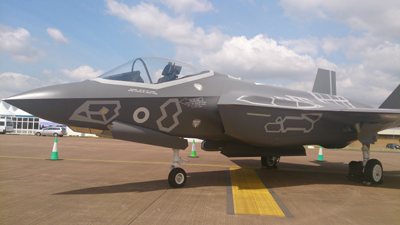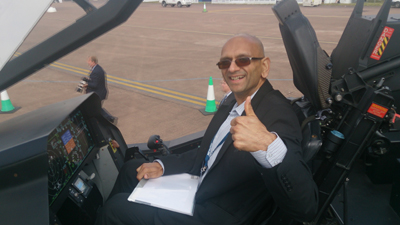While attending the annual Royal International Air Tattoo (RIAT) and the biennial Farnborough International AirShow (FIA) 2014, I had the opportunity to attend a Lockheed Martin F-35/F-16 preview day held at RAF Fairford, the venue for RIAT, as well as taking a few days to attend FIA 2014.
The Lockheed Martin F-35/F-16 preview day included a range of activities including a briefing with Lorraine Martin, General Manager of the F-35 Program. The briefing included a short video showcasing the F-35 Lightening II “fighter of the future” emphasizing the progress that the program is making with 18,000 hours flown on F-35 aircraft.
The importance of air power combined with ageing air frames was highlighted as the impetus behind initiation of the F-35 program. Started as a coalition program to leverage economies of scale, this is now being bolstered by FMS customers with South Korea expected to join confirmed customers Israel and Japan. Ultimately, the F-35 is designed to replace around 9 platforms as well as providing force multiplier capabilities to support additional mission envelopes such as airborne ISR.
 The incorporation of stealth, fused sensor suites and net centric operation defines a fifth generation machine such as the F-22 Raptor. For the F-35, this fifth generation performance is enhanced with the inclusion of a multi-spectral sensor suite, interoperability as well as other capabilities.
The incorporation of stealth, fused sensor suites and net centric operation defines a fifth generation machine such as the F-22 Raptor. For the F-35, this fifth generation performance is enhanced with the inclusion of a multi-spectral sensor suite, interoperability as well as other capabilities.
· Stealth is designed in with the F-35. This includes the use of internal fuel tanks, buried engine and inlets to reduce heat signatures, internal bays to carry the missiles payloads, non-emitting sensors and radar absorbing materials.
· Sensors on the F-35 include the AESA multifunctional radar; the Electro-Optical Targeting Systems (EOTS) which sits on the chin of the aircraft and provides precision air-to-air and air-to-surface targeting capability; the Electronic Warfare (EW) system that incorporates embedded antennas to provide Electronic Support Measures (ESM);
· The Distributed Aperture System (DAS) system which allows the pilot to effectively see through the aircraft;
· Network centric capabilities comprising dedicated F-35-to-F-35 as well as F-35-to-legacy platform communications.
The briefing also provided an update on the current status and future expectations for the program. Software is as important to the future fielding of the aircraft as is the hardware. The main flight software is essentially finished with the Block 2A software release available across the F-35 fleet. This version provides enhanced training including functionality for off-board fusion, initial data links, electronic attack and mission debrief and represents around 86% of the required code for full warfighting capability. Flight testing stands at 60% completion but mission software (that encompasses avionics and sensors common all across all variants) still needs to be completed.
Initial warfighting capability will be provided with the Block 2B release which will also include expanded data links, multi-ship fusion and initial live weapons. The USMC is planning to go operational with 2B, while the final Block 3F software version which will provide 100% of the software required for full warfighting capability is expected to be available in 2017.
Testing is ongoing with missions system testing expected be completed in 2014, and other tests in various stages of completion. Flight testing has included angle of attack (AOA), air start testing (which involves shutting the engine off in flight), tail slide manoeuvres and ongoing testing of weapons.
A roundtable session afforded the opportunity to get some further details on issues such as communications, radar and customer specific configurations:
· Communications - the F-35 has Link 16 capability to enable communications with other platforms, though this type of communication comes at the expense of stealth. The F-35’s MALD system on the other hand is designed for exclusive communication between other F-35s and is designed to extend common situational awareness across a group of F-35s. Studies are underway to investigate how the F-35 platform could share this situational awareness with other fifth generation and fourth generation fighters.
· Radar – upgrades to the radar front-end with potential implementation of GaN-based T/R modules and/or enhancements to the digital backend will be tied into the future Block upgrade cycle of the platform.
· Weapons – a future Block upgrade will add additional weapons to the F-35.
· Electronic Warfare – there is scope to add capabilities using the embedded antenna infrastructure on the platform.
· Sensor fusion will enable data from the various sensors on the F-35 to be compiled into a cohesive picture.
· The combination of stealth, long range sensors and communications reach back will be central to the advantages offered by the F-35 over legacy platforms.
· The OPV option – while the experience of a pilot is going to be central to maximizing the utility of the F-35, optionally piloted or unmanned variants could be a future possibility.
· Customer configurations – demands from international customers have always led to specific variants being developed or, as is the case with Israel, the customer installing unique technologies to meet its own requirements. The F-35 will be no exception with Israel expected to be the first foreign military sales (FMS) customer to receive F-35s that will feature IAF-compatible C4I systems with additional indigenous capabilities such as an external Elisra EW pod and Rafael munitions and missiles, to be added at a later stage.
 A full scale model of the F-35 was available for viewing at both RAF Fairford and Farnborough. I was able to sit in the cockpit of the full-scale model as well as take a tour of the plane with Al Norman, Chief F-35 Test Pilot who was also an experimental test pilot for the F-22 as well as serving in the USAF for 23 years as a fighter pilot and test pilot. During the tour, the use of electrohydrostatic actuators for flight control was highlighted as well as the triple redundancy and graceful degradation of systems to enhance survivability of the aircraft.
A full scale model of the F-35 was available for viewing at both RAF Fairford and Farnborough. I was able to sit in the cockpit of the full-scale model as well as take a tour of the plane with Al Norman, Chief F-35 Test Pilot who was also an experimental test pilot for the F-22 as well as serving in the USAF for 23 years as a fighter pilot and test pilot. During the tour, the use of electrohydrostatic actuators for flight control was highlighted as well as the triple redundancy and graceful degradation of systems to enhance survivability of the aircraft.
There are currently 106 F-35 aircraft flying and Lockheed Martin projects these numbers to increase to 400 by 2018 (including aircraft to partners and customers) with the cost expected fall below $100 million as production increases.
Interestingly this will place the F-35 cost on a par with fourth generation fighters, so will Lockheed Martin be effectively cannibalising sales of the F-16 moving forwards? As with all military technology, the issue of cost will not necessarily drive the sale of a platform but will also be dictated by political willingness to submit a platform for a particular contest so the reality is that the F-16 option will remain on the table for the foreseeable future.
An update to the F-16 program was provided by Bill McHenry, Director for the F-16 Program, who provided an update on the status of the F-16 Program, including a review of recent activities and a closer look at the F-16V configuration. The F-16V configuration is designed to offer enhancements based around an AESA radar, coupled with the backend architectural improvements needed to process the additional data generated as well as support improvements to the display. Taiwan’s F-16 fleet was originally slated to be part of the CAPES (Combat Avionics Programmed Extension Suite) upgrade program, but the budgetary uncertainty around CAPES has resulted in Taiwan becoming the first customer for the F-16V with production hardware and kits, underpinned by the Northrop Grumman SABR radar, to be delivered in 2017.
The USAF CAPES program originally called for 300 to 350 aircraft to be upgraded but was impacted by budget cutbacks. However, with ongoing operational requirements, the budgetary requests have been modified to focus on a service life extension program (SLEP), which will look to include an AESA radar alongside structural improvements to the airframe, as well as upgrades to the core mission computer and cockpit display.
Also discussed was the F-16 Block 61 configuration; the UAE has requested 30 aircraft which will be different from the country’s stock Block 60 fleet. The UAE operates the Block 60s which incorporate the Northrop Grumman AN/APG-80 AESA radar, as well as featuring the highest thrust engine and the Northrop Grumman AN/ASQ-28 IFTS (Internal FLIR and Targeting System) amongst other improvements, effectively putting it a half generation ahead of the Block 50/52+ aircraft operated by the USAF and other operators. It appears that the Block 61 aircraft will incorporate a set of component improvements including the incorporation of additional weapons support and obsolescence management. Some reports suggest that either the Raytheon RACR or Northrop Grumman SABR AESA radars could also be part of the offering though a roundtable discussion suggested the Block 61 aircraft would retain use of the AN/APG-80 radar.
Current production of the F-16 is expected to end in 2017 but Lockheed Martin is looking to reduce costs as a means of targeting sales to additional customers and extend production beyond this timeframe.
Finally, while Boeing is offering remotely piloted F-16s (QF-16s) for use as as aerial targets and decoys for testing against air-air missiles, radars, surface-air missiles, the potential use of F-16s as UCAVs remains an option according to Lockheed Martin, though one that is not being actively investigated at the time of writing.
